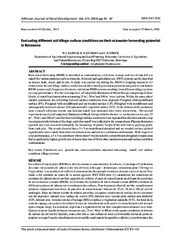| dc.contributor.author | Baipusi, W.J. | |
| dc.contributor.author | Kayombo, B. | |
| dc.contributor.author | Patrick, C. | |
| dc.date.accessioned | 2023-02-15T09:55:52Z | |
| dc.date.available | 2023-02-15T09:55:52Z | |
| dc.date.issued | 2015-10-03 | |
| dc.identifier.citation | Wright, J. B., Kayombo, B., & Patrick, C. (2016). Evaluating different soil tillage surface conditions on their rainwater harvesting potential in Botswana. African Journal of Rural Development (AFJRD), 1(1978-2017-2067), 91-97. | en_US |
| dc.identifier.issn | 2415-2838 | |
| dc.identifier.uri | https://ageconsearch.umn.edu/record/263631/ | |
| dc.identifier.uri | https://hdl.handle.net/13049/631 | |
| dc.description | Journal Article | en_US |
| dc.description.abstract | Rain water harvesting (RWH) is described as concentration, collection, storage and use of rain fall via runoff for various purposes such as domestic, livestock and agricultural use. RWH systems can be classified as macro, mini, micro and in-situ. A study was carried out during the 2013/14 cropping season to (1) characterize the soil tillage surface conditions on their runoff generation potential using micro-catchment RWH systems and (2) appraise the micro-catchment RWH systems resulting from different tillage systems on crop performance. For the first objective, a Completely Randomized Block Design comprising of three blocks of runoff/catchment plots measuring 25 m2 , 50 m2 and 100 m2 were laid out. Within the same plots/ rainfall catchment, the following four soil surface conditions were imposed: Ploughed with mouldboard surface (PS), Ploughed with mouldboard and un-weeded surface (UP), Ploughed with mouldboard and subsequently harrowed surface (HS) and naturally vegetated surface (NV). At the bottom of the catchment area, a runoff collection system was laid and runoff was measured after every storm event. The second experiment was also a Completely Randomized Block Design with two factors i.e. catchment size (in-situ, 25 m2 , 50 m2 , and 100 m2 ) and the four soil tillage surface conditions were repeated but this time a maize crop was planted at the bottom of the slope, such that runoff was collected at the cropped area. Plant performance (growth rate) was assessed fortnightly, by measuring 10 plants’ height of the mid-leaf or growing point, from each plot. The results showed that a 5 x 5 m mouldboard ploughed and un-weeded surface yielded significantly more runoff than other catchment areas and surface condition combinations. With respect to crop performance, a 5 x 5 m catchment whose runoff was directed to a mouldboard ploughed cropped area had a significantly higher growth rate of maize than run-off from other catchment areas and surface condition combinations. | en_US |
| dc.language.iso | en | en_US |
| dc.publisher | African Journal of Rural Development (AFJRD) | en_US |
| dc.relation.ispartofseries | African Journal of Rural Development;Vol. 1(1): 2016: pp. 91 - 97 | |
| dc.subject | Catchment size | en_US |
| dc.subject | Growth rate | en_US |
| dc.subject | Micro-catchment rainwater harvesting | en_US |
| dc.subject | Runoff | en_US |
| dc.subject | Soil surface condition | en_US |
| dc.subject | Tillage systems | en_US |
| dc.title | Evaluating different soil tillage surface conditions on their rainwater harvesting potential in Botswana | en_US |
| dc.type | Article | en_US |

